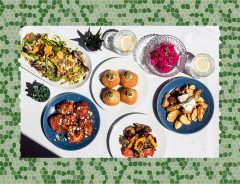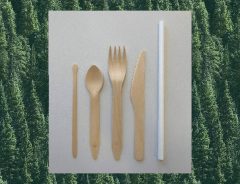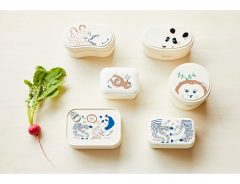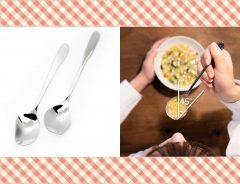- Tags:
- edible plates / Marushige Seika / plastic waste / sustainable / Tableware
Related Article
-

All-organic and plant-based delicatessen Glean by OneBite opens in Shibuya
-

McDonald’s Japan to begin providing wood utensils and paper straws nationwide
-

New mouth cover fuses Mizuno’s sports material with Sony’s 100% recycled waste biomass fabric
-

Hello Kitty interviews Japanese marine-earth science R&D agency on plastic waste problem
-

Bento lunch box series is first in Japan to be made from environment-friendly rice resin
-

“Soup Sage” spoons by Yamazaki Tableware are ergonomically designed for ease of use



We live in a disposable world. Eager consumers lineup outside of Apple stores as the iPhone supercycle accelerates, and marine life is awash with the disposable plastics clogging the world's oceans. Just consider how much waste is generated in a week’s time by run-of-the-mill consumption. Multiplied across billions of people, the amount is staggering to imagine.
Some consumers and businesses, however, are beginning to question the status quo of waste and want. The 2020 Tokyo Olympics were organized as a sustainable event prior to their postponement, and more and more businesses are taking up the mantle of environmentalism. Take MONDO DESIGN, for example. They recently launched PLASTICITY, a sustainable fashion brand that makes chic apparel from discarded plastic umbrellas. Pretty cool.
They are not alone in their desire to clean up the globe. Marushige Seika, a confectionery company based in Hekinan, Aichi Prefecture, is attempting to limit the worrisome amount of waste that goes hand in hand with dining out or getting take out.
An Ecological Pivot
Personally, I feel despondent after ordering take out and throwing away mountains of plastic dishware. Half of the discarded utensils and dining ware I never even open. It seems Katsuhiko Sakakibara, the managing director of Marushige Seika, feels the same. Recently his company introduced a line of crunchy, ice cream cone-like edible crockery.
The company's pivot toward environmentalism was surprisingly reasonable and seemingly straightforward. Marushige Seika began in 1983 as a dessert company producing wafer shells for monaka, a Japanese sweet that contains sweet azuki bean paste sandwiched between wafers made from rice cake.
Yet, as society awoke to the plastic problem in Japan and around the world, Sakakibara and his company noticed an eco-friendly opportunity. The business owner told CNN, "When I go to food festivals, I see bins filled with garbage, and I wondered if our manufacturing technology could do something to change it. So we decided to go beyond ice cream cones and to develop plates that are edible. The key question was how to strengthen the waterproof-ness for the plates.”
Edible Plates
© PR Times, Inc.
With the goal of reducing the global use and waste of plastics, Marushige Seika developed the e-tray, durable oval and rectangular shape trays that are strong enough, and water-resistant enough to hold food. Similar in composition and texture to an ice cream cone, they are crispy and crunchy and about 5 millimeters or so thick. Unlike ice cream cones, the trays are made potato starch in order to make them sturdy. They are cooked in metal trays, where intense pressure makes them become hard and resistant to moisture. The edible trays come in onion, sweet potato, shrimp crackers, and corn flavors.
“If edible crockery became prevalent throughout society and replaced plastic, it would bring about a serious environmental benefit,” Sakakibara told the JapanTimes. “Even if the plates are discarded and left uneaten, they will decompose faster than biodegradable plastics, or become food for animals,” Sakakibara continued.
Marushige Seika primarily targets outdoor events where spectators often discard lots amount of plastic utensils and trays. In recent years, the company has benefited from a marked increase in sales. "I guess that reflected a growing public concern with (the damage done by) plastic waste," Sakakibara noted. With the public on its side, the company expanded its lineup to include edible chopsticks in 2017. Edible spoons, Sakakibara says, are up next.
The Challenges Preventing Wider Adoption
So, should consumers expect to find e-trays in their take out orders? Will vendors at city festivals be serving takoyaki in disposable dishes sometime soon? The answer, unfortunately, appears to be "not yet."
While interest is clearly growing, there are several obstacles preventing widespread adoption. First and foremost is the cost. E-trays cost about 50 JPY ($0.47) apiece, significantly more than the plastic alternative. Also, some restaurant-goers are reluctant to eat the plate if it has been in contact with a dirty surface, say a poorly tended table.
Nevertheless, as environmental concerns become more common among consumers, it's not difficult to imagine venues and restaurants offering take-out to offer the option to eco-minded customers. Even if the trays are discarded afterward, their constituent starch will have much less of an ecological impact than non-degradable plastics.
Those interested can purchase e-trays here and edible chopsticks here.